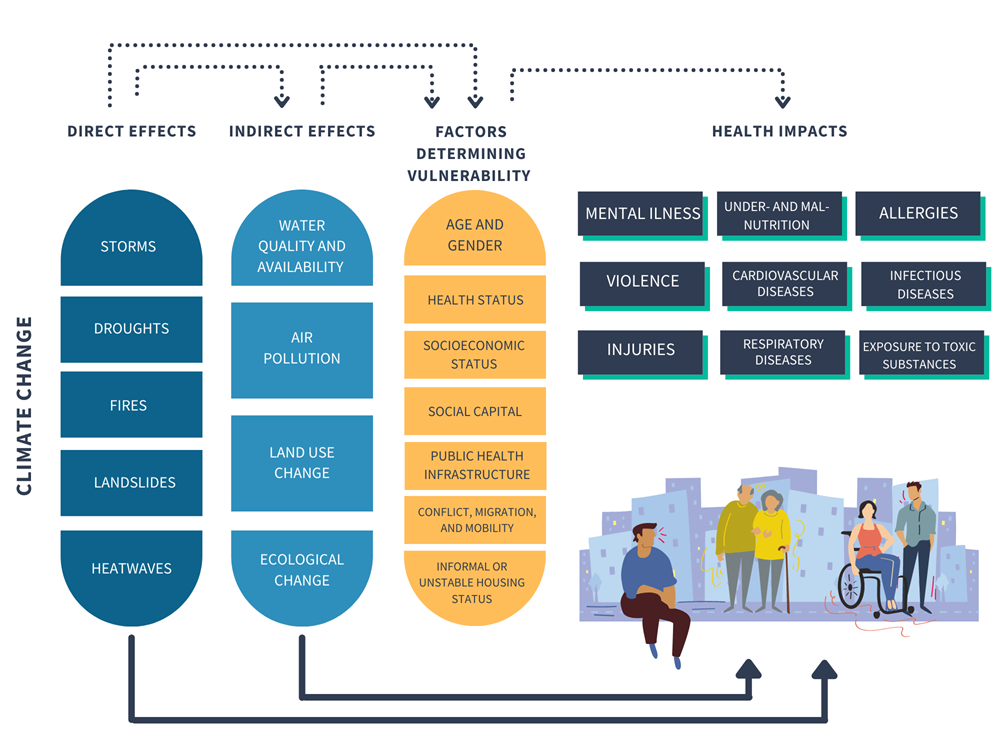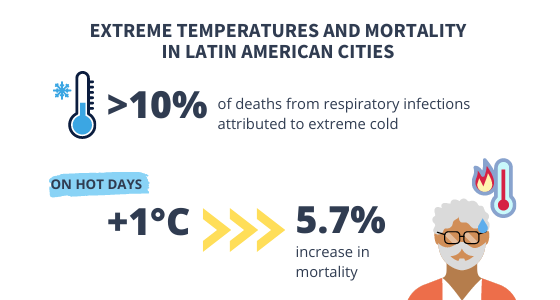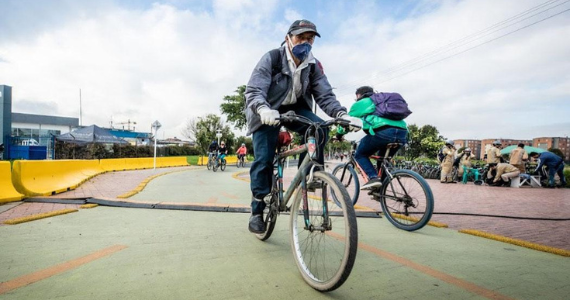Getting Warmer: The Impact of Extreme Temperatures on Health in Latin American Cities
Posted on
June 28, 2022
By: Leena Kwak
Climate change continues to have an increasing effect on lives around the world, but the impacts of rising temperatures and extreme weather events on health are magnified in urban areas. Cities often reside in low-lying coastal areas that are especially vulnerable to extreme weather events. Paving and other development patterns can increase the risk of severe flooding and landslides and built materials like concrete also absorb heat, causing temperatures to rise and increasing the severity of heat waves.
In Latin America, 80% of people live in urban areas and are increasingly impacted by the health risks of climate change, yet research on these impacts is lacking. A team of SALURBAL researchers and other partners is working to fill this gap by analyzing the impacts of past extreme heat events on health and mortality in Latin American cities, and how future extreme heat events will affect people’s health.
Long-term changes in temperatures and weather patterns have direct and indirect effects on health, especially in urban areas. The direct impacts of climate change can be seen in the increased likelihood and severity of extreme weather events like flooding, landslides, or fires. These events by themselves can cause injury, increase the spread of diseases, and lead to premature death. There are also many indirect effects of climate change on health that often unequally impact vulnerable populations. Air pollution, water quality and availability, and changes in land use are all impacted by increasing temperature and extreme weather events. In turn, these changes can cause health issues like respiratory diseases, malnutrition, and even increased violence. Populations with prior health problems, older adults, or those without access to healthcare bear the burden of these issues unequally.
One of the most pressing impacts of climate change is a rise in extreme temperatures and an increase in the frequency and intensity of heat waves. In South America’s largest cities, the frequency of extremely hot days is projected to increase by five to ten times by mid-century.

A recent SALURBAL study investigated the impact of extreme temperatures on mortality in 326 Latin American cities. The study, highlighted in a recent Nature Research Brief, found that nearly 6% of all deaths in the population studied can be linked to extreme temperatures. Older adults are most vulnerable to the increasing heat, with cardiorespiratory deaths particularly affected. This research showed that on extremely hot days, a one-degree Celsius increase in temperature correlated to a 5.7% increase in deaths. On the opposite end, 10% of cardiovascular deaths were related to extreme cold temperatures. These findings emphasize that an increase in significantly hot and cold days comes with serious health consequences–especially in urban areas.

Source: Kephart et al., Nature Medicine, 2022
Latin American cities need to take immediate action to mitigate the negative impact of extreme temperatures on human health. Identifying at-risk populations, adjusting critical infrastructure, and significantly reducing greenhouse gas emissions are all urgently needed actions to protect human health in this region.

Source: Bogota.gov.co
Many cities have already taken action to address the effects of extreme heat and climate change. In Bogotá, Colombia, a new public policy plan was recently written to guide urban planning for the next 12 years. The new plan, (the Plan de Ordenamiento Territorial, or “POT”), features a more sustainable transportation model based on expanding the railway system with two new regional lines and prioritizing bicyclists and pedestrians. The new POT outlines a policy to double the number of bike lanes in Bogotá by 2030, and install 32 new green corridors to encourage public space use and pedestrian mobility. The plan also proposes expanding protected green spaces in the urban area (la Estructura Ecológia Principal) by about 30%. With a strategy to improve public transportation and increase protected green space, Bogotá is taking action to reduce its greenhouse gas emissions. If followed through, these efforts will help mitigate the rising temperatures in the city and prioritize the health of Bogotá’s citizens.
The CityAdapt project is working to promote climate resilience in urban areas in the cities of Xalapa, Mexico and San Salvador, El Salvador. CityAdapt employs Ecosystem-based Adaptation (EbA) to use natural solutions to adapt to climate change. In San Salvador, CityAdapt is working to restore 1,150 hectares of forests and coffee plantations to increase the ground’s ability to absorb rainfall and reduce the risk of flooding and landslides. This innovation is known as 'sponge cities,' because vegetation acts like a sponge to hold water in the ground, preventing erosion and floods and storing water for times of drought. By restoring vegetation instead of rebuilding concrete, San Salvador can increase its ground permeability while also working to prevent the rise of extreme temperatures. This project has already helped reduce the risk of flooding for 16,000 people and is predicted to help 115,000 people by the project’s end. Although its main goal is to reduce the risk of flooding and erosion, restoring natural habitation in San Salvador increases shade and heat absorption which in turn helps to lower the risk of extreme temperatures in the region.
Starting in 2017, the Green Corridors Project in Medellín, Colombia is another environmental initiative to mitigate extreme temperatures in the city. The urban planning project has created a network of 30 green corridors across the city to reduce rising temperatures while also providing a cool environment of greenery for pedestrians and bikers. The corridors have provided a multitude of environmental benefits including decreasing temperatures by 2°C, improving air quality, and increasing biodiversity. Although this initiative has helped lower temperatures, its effects are mostly felt in Medellín’s center. The surrounding more vulnerable poor neighborhoods and hillside slums still need more lack greenspace vegetation and big parklands to curb extreme temperatures.
These case studies highlight important actions that are being taken to reduce extreme temperatures in Latin American cities, but there is an urgent need to do more. Worldwide, over five million deaths are associated with extreme hot and cold temperatures every year. A recent study across 43 countries estimated that 37% of warm-season heat-related deaths could be attributed to climate change, and that resulting increases in mortality are evident on every continent. In Latin American cities and across the globe, urgent measures must be taken to reduce temperatures and confront the severe health impacts of climate change. The future of our planet–and our human health–depends on it.